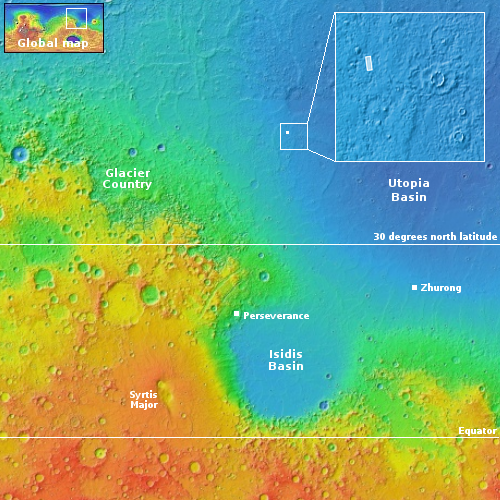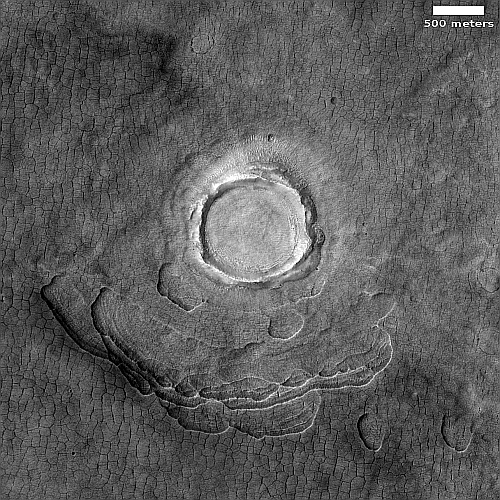Polygons and scallops in the high mid-latitudes of the Martian lowland plains
Cool image time! Only yesterday I posted an image of polygons in the dry equatorial regions of Mars, where little evidence of near-surface ice is found and are thought to be the remnants from a long-dried lakebed.
Today we take a look at some polygons in the mid-latitudes of the icy northern lowland plains, where near-surface ice appears ubiquitous and as it sublimates away with the changing seasons causes all kinds of strange formations, including polygons.
The picture to the right, cropped, reduced, and sharpened to post here, is a good example, centered on a 0.6-mile-wide bright crater that appears to be filled with glacial ice. The image was taken on June 22, 2023 by the high resolution camera on Mars Reconnaissance Orbiter (MRO), and is located at 44 degrees north latitude on the western edge of Utopia Basin. As noted by the MRO science team in 2006 for a different MRO picture with similar features:

The scalloped depressions are typical features; a smooth layered terrain located between 40 and 60 degrees in both hemispheres. Scalloped depressions probably form by removal of ice-rich subsurface material by sublimation (ice transforming directly from a solid to a gaseous state), a process that may still be active today. Isolated scalloped depressions generally have a steep pole-facing scarp and a gentler equator-facing slope. This asymmetry is interpreted as being the result of difference in solar heating. Scalloped depressions may coalesce, leading to the formation of large areas of pitted terrain.
The polygonal pattern of fractures resembles permafrost polygons that form in terrestrial polar and high alpine regions by seasonal-to-annual contraction of the permafrost (permanently frozen ground). On Earth, such polygons indicate the presence of ground ice.
On the overview map to the right the white dot marks the location. The inset illustrates the icy nature of the surface at these latitudes in the northern plains, with several much larger craters nearby (the largest about 35 miles across) surrounded by frozen splash aprons.
On Christmas Eve 1968 three Americans became the first humans to visit another world. What they did to celebrate was unexpected and profound, and will be remembered throughout all human history. Genesis: the Story of Apollo 8, Robert Zimmerman's classic history of humanity's first journey to another world, tells that story, and it is now available as both an ebook and an audiobook, both with a foreword by Valerie Anders and a new introduction by Robert Zimmerman.
The print edition can be purchased at Amazon or from any other book seller. If you want an autographed copy the price is $60 for the hardback and $45 for the paperback, plus $8 shipping for each. Go here for purchasing details. The ebook is available everywhere for $5.99 (before discount) at amazon, or direct from my ebook publisher, ebookit. If you buy it from ebookit you don't support the big tech companies and the author gets a bigger cut much sooner.
The audiobook is also available at all these vendors, and is also free with a 30-day trial membership to Audible.
"Not simply about one mission, [Genesis] is also the history of America's quest for the moon... Zimmerman has done a masterful job of tying disparate events together into a solid account of one of America's greatest human triumphs."--San Antonio Express-News
Cool image time! Only yesterday I posted an image of polygons in the dry equatorial regions of Mars, where little evidence of near-surface ice is found and are thought to be the remnants from a long-dried lakebed.
Today we take a look at some polygons in the mid-latitudes of the icy northern lowland plains, where near-surface ice appears ubiquitous and as it sublimates away with the changing seasons causes all kinds of strange formations, including polygons.
The picture to the right, cropped, reduced, and sharpened to post here, is a good example, centered on a 0.6-mile-wide bright crater that appears to be filled with glacial ice. The image was taken on June 22, 2023 by the high resolution camera on Mars Reconnaissance Orbiter (MRO), and is located at 44 degrees north latitude on the western edge of Utopia Basin. As noted by the MRO science team in 2006 for a different MRO picture with similar features:

The scalloped depressions are typical features; a smooth layered terrain located between 40 and 60 degrees in both hemispheres. Scalloped depressions probably form by removal of ice-rich subsurface material by sublimation (ice transforming directly from a solid to a gaseous state), a process that may still be active today. Isolated scalloped depressions generally have a steep pole-facing scarp and a gentler equator-facing slope. This asymmetry is interpreted as being the result of difference in solar heating. Scalloped depressions may coalesce, leading to the formation of large areas of pitted terrain.
The polygonal pattern of fractures resembles permafrost polygons that form in terrestrial polar and high alpine regions by seasonal-to-annual contraction of the permafrost (permanently frozen ground). On Earth, such polygons indicate the presence of ground ice.
On the overview map to the right the white dot marks the location. The inset illustrates the icy nature of the surface at these latitudes in the northern plains, with several much larger craters nearby (the largest about 35 miles across) surrounded by frozen splash aprons.
On Christmas Eve 1968 three Americans became the first humans to visit another world. What they did to celebrate was unexpected and profound, and will be remembered throughout all human history. Genesis: the Story of Apollo 8, Robert Zimmerman's classic history of humanity's first journey to another world, tells that story, and it is now available as both an ebook and an audiobook, both with a foreword by Valerie Anders and a new introduction by Robert Zimmerman.
The print edition can be purchased at Amazon or from any other book seller. If you want an autographed copy the price is $60 for the hardback and $45 for the paperback, plus $8 shipping for each. Go here for purchasing details. The ebook is available everywhere for $5.99 (before discount) at amazon, or direct from my ebook publisher, ebookit. If you buy it from ebookit you don't support the big tech companies and the author gets a bigger cut much sooner.
The audiobook is also available at all these vendors, and is also free with a 30-day trial membership to Audible.
"Not simply about one mission, [Genesis] is also the history of America's quest for the moon... Zimmerman has done a masterful job of tying disparate events together into a solid account of one of America's greatest human triumphs."--San Antonio Express-News


